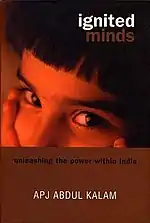Ignited Minds
Ignited Minds: Unleashing the Power Within India (2002, ISBN 0-670-04928-X) is a book written by A. P. J. Abdul Kalam, who was the President of India from 2002 to 2007.[1][2] Ignited Minds is a logical step forward from Dr. Kalam's earlier book, India 2020: A Vision for the New Millennium (1998, ISBN 0-670-88271-2). This book consists of many inspirational messages by A P J Abdul Kalam.

Dr. Kalam has dedicated Ignited Minds to an intermediate school child, named Snehal Thakkar, whom he met at a school and while talking to his students, a question had come up: "Who is our enemy?". Kalam recalled that many answers came up, but the answer on which all agreed came from his (Snehal Thakkar): "Our enemy is poverty". The small book of 205 pages contains dynamic and original ideas, examines attitudes afflicting the Indians, and present prescriptions for rapid growth of India to enable the country to emerge as a developed country. The scientist and the seer inside Kalam has addressed the book to young citizen(s) of India. This book has been the most wanted and demanded all over the world after the death of Abdul Kalam.
Chapters
The book is organised into eleven chapters, dealing with various issues. These chapters are:
- The Dreams and the Message
- Give Us a Role Model
- Visionary Teachers and Scientists
- Learning from Saints and Seers
- Patriotism beyond Politics and Religion
- The Knowledge Society
- Getting the Forces Together
- Building a New State
- To my Countrymen
- Conclusion
- Bibliography
Synopsis
- The book begins with a sad note. On 30 September 2001, Kalam’s helicopter, while on its way from Ranchi, Jharkhand state, India to Bokaro
crashed, but all aboard miraculously survived. He was administered that night a tranquilizer, and he recalls having seen a very vivid dream. He writes in the book that he saw himself in a desert “with miles of sand all around," and there stood five men, namely, Caliph Omar(R.A) or Umar, Emperor Ashoka, Mahatma Gandhi, Albert Einstein, Abraham Lincoln. Kalam felt dwarfed by their presence, and recounts the words of these great personalities.
In this chapter Kalam has written "Dream, dream, dream, dreams transform into thoughts and thoughts result in action" - The next chapter emphasises the importance of mother, father and elementary school teachers as role models.
- The third chapter tells that "Vision ignites the minds", and talks about the modern Indian visionaries like J. R. D. Tata, Vikram Sarabhai, Satish Dhawan and Dr. Verghese Kurien.
- The next section of the book deals with the spiritual heritage of the Indian nation and talks about developing a model of development based on India's inherent strengths.
- The fifth chapter of the book exhorts the Indians, constituting a nation of one billion people "with multitude faiths and ideologies" to develop a "national vision" and amalgamate into one "national forum."
- The next chapter begins with a Thirukkural, which states:
"Wisdom is a weapon to ward off destruction;
It is an inner fortress which enemies cannot destroy".
This chapter reminds the readers that Ancient India was a "knowledge society that contributed a great deal to civilization." - The caption line of the seventh chapter is followed by the following inspiring words of Abraham Lincoln:
"Determine that things can and shall be done, and then we shall find the way." - The eighth chapter exhorts for a change in the mindset and to take pragmatic risks, which shall result in success.
- The ninth and the last chapter, with the caption line of "To My Countrymen" begins with few words of the Nobel laureate, Rabindranath Tagore - "let my country awake."
- The book ends with a "Song of Youth", with these opening words:
"As a young citizen of India,
armed with technology and love for my nation,
I realize, a small aim is a crime."
See also
References
- "Nuclear Scientist, 70, a Folk Hero, Is Elected India's President". The New York Times. 19 July 2002. Retrieved 14 December 2010.
- "Kalam, the finest President in India: Lord Paul". The Times of India. 3 January 2004. Retrieved 14 December 2010.
External links
- Ignited Minds at Goodreads